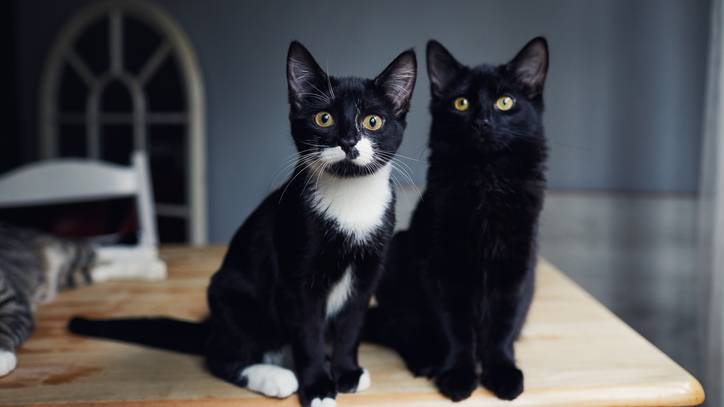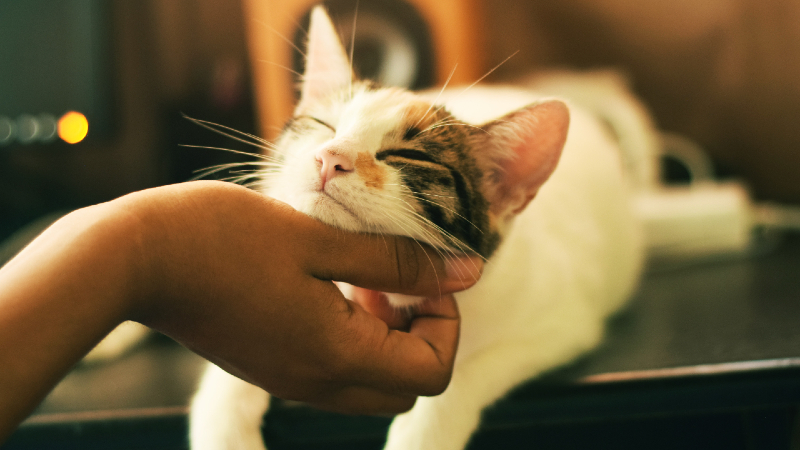Cat body language: 31 behavioral traits explained, including signs of a happy cat
Looking to learn as much as you can about cat body language? This guide has everything you need to help you understand what your feline friend is trying to say

Learning how to decipher cat body language will not only help you understand and communicate with your pet, but it will also strengthen your bond.
It can be difficult to read what your cat is thinking not only because they’re not as expressive as dogs, but because their body language can be misinterpreted.
For example, you may think your cat is happy if it has its tail straight up in the air, but if its fur is standing up at the same time, this could signal fear or anxiety instead. There's no denying that cat communication can be a little more difficult to navigate than that of our canine companions but with a little bit of background knowledge, you'll be an expert cat whisperer in no time.
Below we walk you through how cats communicate with humans as well as each other and reveal the most common forms of body language so that you can better understand your feline friend.
So, what are you waiting for? Read on as we take you on a journey into the world of your kitty and help you uncover the secrets to a happy cat.
How do cats communicate with humans?
While we may not speak the same language, cats communicate with humans in a number of verbal and non-verbal ways.
Verbally, this tends to come primarily in the form of meowing. Meowing is actually only used to communicate with humans. While kittens may meow at their mothers, adult cats don’t actually meow at each other.
Get the best advice, tips and top tech for your beloved Pets
Meows can be used as a greeting, when they want something or to tell us when something is wrong. Cats also communicate by purring or chirping when they are happy or looking for comfort, hissing and howling when scared, stressed or in pain.
Non-verbal communication includes their body language and behavior. A cat’s posture, tail position, as well as what their eyes, ears and whiskers are doing are all indicative of their mood.
For example, if a cat tucks its tail between its legs it could be scared or anxious. Similarly, its learning certain behaviors will help you better understand your cat. You may ask yourself why they’re pawing at your leg or staring at you, but these are simply signs of affection.

How do cats communicate with other cats?
Cats use a number of methods to communicate with other cats. These include verbal, physical and even chemical.
Vocalizations used to communicate with other cats are similar to those used with humans: trills, growls, hisses and purrs. Cats use different pitches, volumes and levels of intensity to express these vocalizations so if they’re anxious they may let out an intense, loud meow and if they’re happy it may be a softer, less intense meow.
Body language and chemical cues are also used between cats. When they greet each other they touch noses and rub up against each other to give off their scent. They may even hook tails as a sign of affection. Their body language is similar to that used with humans.
A friendly cat will hold its tail high and perk its ears forward, blinking its eyes slowly. However there are additional signs too. Licking the top of each other’s head is a sign of affection and by sniffing each other’s bottoms and play biting they form a social bond.
What does my cat's body language mean?
Your cat’s body language and actions are a guide to understanding them. This is what they’re telling you:
Body language signals
- Ears, eyes and whiskers A happy cat usually has a relaxed face and whiskers, forward facing ears with slightly slit pupils. An angry cat has flat ears, slit eyes and backward-facing whiskers. A scared cat has wide, dilated pupils, slightly flattened ears and backward-facing whiskers.
- Body If a cat’s body is relaxed and facing towards you they are generally content. An arched back is a sign of anger or aggression if they feel threatened and if they crouch or curl their body up into a ball it’s a sign of stress or fear.
- Tail A high tail tends to mean a happy cat unless their heckles are raised at the same time. A downward pointing tail or tucked tail signal fear or anxiety and if you want to know why cats wag their tails this could be that they’re unhappy, annoyed or in pain.
While this is a general guide, it’s important to watch your cat’s body language in context of the situation they’re in. A cat may have wide eyes when scared, but also when attentive for example.
Behavior
- Knocking things over As natural hunters your cat will like to investigate, but they also like to play. When they knock things over they could just be having fun or looking for attention. Try to make sure your cat has enough interactive toys and is getting enough physical and mental stimulation.
- Scratching furniture Scratching is another instinctive behavior for cats. They need to scratch to mark their territory and sharpen their claws. Make sure you provide your cat with scratching posts to stop them destroying your furniture.
- Licking Cats lick themselves as a form of grooming, but when they lick you it’s a sign of affection. Just like their mother grooms them when they’re young, this is how they form a bond with you. If you’re curious why your cat licks their lips, a vet gives seven reasons why in this feature.
- Sitting in tight spaces Have you ever wondered why your cat has squeezed itself into that shoebox? Cats like fitting into small spaces as it makes them feel warm, safe and secure. It seems odd, but actually it’s quite logical.
- Drinking from the faucet Cats are wild animals and as such they seek running water such as a stream. This is why they may choose to drink water from a running faucet instead of from their water bowl. If they do this try changing their bowl in case they don’t like how it feels on their whiskers or move it to a position where they may feel less vulnerable.
- Zoomies – Wondering what to do if your cat has the zoomies? This is when your cat zooms around the house in a hyperactive way. It’s simply them getting rid of excess energy. Try ensure they have enough toys spread across the house and feed them their biggest meal at night so they’re not too full and lazing around all day.

How to tell if your cat is happy or not
Want to know if your cat is happy or not? You may know why your cat likes high places and what the best cat treats are to spoil your kitty, but are they content? Learn to read their mood and emotions by understanding their body language:
- Happy A happy cat is a relaxed cat. An upright tail with a slight c-curve at the tip is just one sign of a happy cat. They will generally have soft eyes (not wide open) and if they’re happy in your company they’ll stare at you and blink slowly to show they’re comfortable. They may also roll over, expose their belly and purr at you.
- Scared If your cat is afraid they may crouch down, tail tucked in with their ears flat back or run away and hide. They may also stand with their back arched and hair raised hissing or growling with wide, dilated pupils.
- Stressed If your cat is stressed they may be restless causing them to bite or scratch around the house or to over-groom themselves. They may crouch low to the ground with their tail low or tucked in or they may even hide.
- Angry If a cat feels threatened it will arch its back and its body will stiffen. Its ears will be pulled back, pupils will be constricted, whiskers pointing forward and teeth bared when it’s angry. Other signs of anger or annoyance include a wagging or thumping tail and growls or hisses.
How can you tell if your cat loves you?
You’ve learnt your cat’s likes and dislikes and you’re doing everything you can to ensure they’re healthy, safe and happy. You love them unconditionally. But is the feeling mutual? Find out how to know if your cat loves you with these 10 signs:
- Grooming Cats lick each other to bond with each other, but also to spread their scent and establish their group so when your cat licks you they’re telling you you’re their family. If they treat you like you’re a cat, that’s a sure sign of love.
- Biting Don’t be mad if you cat nips at your fingers. This can be a sign of affection. Cats will bite each other when they playing and this is the same with humans. However, biting can also mean your cat wants you to stop petting them, that they want attention or that they’re teething. You’ll need to learn to read the situation.
- Blinking Generally cats don’t like direct eye contact as it makes them feel threatened so if they stare at you and blink slowly it’s a sign that they’re comfortable with you.
- Headbutting Cats headbutt each other to mark their territory and spread their scent so when they headbutt you or rub themselves up against you they’re marking you as someone who they trust and feel safe with.
- Kneading If you want to know why your cat kneads you, it’s a sign of affection. When they are young, kittens knead their mother’s stomach to stimulate milk production. When your cat kneads your lap they are showing you the same bond they have with their mother.
- Gifting presents You may not be too pleased when your cat brings you a dead mouse or bird, but they’re actually trying to do something nice for you by bringing you a gift.
- Following you around If your cat loves even if they’re not affectionate they’ll want to be near you. They will follow you around if they want company, attention or someone to play with. Just remember it may be something else so make sure you watch their body language as they could be trying to tell you something like they’re ill or suffering from separation anxiety.
- Showing their belly A cat’s belly is a vulnerable spot so if they lie on the floor or roll over to show you their stomach they’re showing you their vulnerable side. This is a sign that they trust and love you. It may also mean they want to play.
- Sleeping on you Sleeping is another vulnerable state. If your cat likes to sleep on your lap or in your bed with you, they feel safe and protected with you.
- Purring and curved tail If your cat’s body language and vocalizations suggest a happy cat, they probably love the company they’re in. A purring cat is generally content, but be careful not to confuse it with nerves if their ears are folded back. And a tail up in the air with a slight curve is friendly and playful.

How to tell if a cat is in pain
It’s important to understand when your cat needs to go to the vet. These are all signs your cat may be in pain:
- Change in appetite If you cat has lost their appetite and doesn’t seem interested in their food their teeth could be hurting them.
- Loss of energy and changes in movement If they’re not as active as usual and is moving differently, for example, if they’re limping or if they don’t want to sit on your lap and be touched, this could be because they’re suffering.
- Body language If you cat is showing tension in their body, if they’re crouching or lowering their head this could be a sign that they’re in pain. They may also close or squint their eyes and flatten their ears.
- Change in sleep habits Pain may cause insomnia in cats if they can’t sleep because of what’s ailing them.
- Change in grooming habits If your cat is in pain they may stop grooming themselves to avoid changing positions and aggravating the sore spot.
- Change in mood Your cat may become irritable if they’re distressed, which could lead to vocalizations such as urgent meowing, hissing or growling.
- Change in behavior Just like humans, when cats are in pain they may become withdrawn and lose interest in things as they try to cope with the pain.
- Litterbox accidents If your cat is in pain they may find it difficult to get in and out of their litterbox or to squat so there may be accidents when they need the toilet.
Want more cat body language content? Check out this vet nurse’s guide that answers, ‘Why does my cat drool when I pet him?’ You might also be questioning, ‘Why is my cat shaking?’ For the answer, take a look at our vet’s guide. Or, learn all about weird cat behaviors, like why cats play with their tails.

